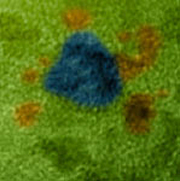- Number 315 |
- July 6, 2010
Opposites attract and inspire electrocatalyst

Gold particles (colored in blue)
will surround themselves with
even smaller platinum particles
(colored in orange), creating
a structure that could turn a
common preservative into
electricity in a fuel cell.
Tiny gold particles surround themselves with even smaller platinum bits, creating a complex structure that could turn a common preservative, formic acid, into electricity in a fuel cell, according to scientists from China's Harbin Institute of Technology and DOE’s Pacific Northwest National Laboratory. The team used a novel electrostatic self-assembly method to create platinum-surrounded gold nanomaterial. This method relies on the attraction between positive and negative charges to inspire nanoparticles to form new structures on their own. "To our knowledge, this is the first time that this method has been used to create such catalysts," said Dr. Yuehe Lin, a chemist at PNNL and a co-corresponding author of the paper. This paper was named a Very Important Paper by Angewandte Chemie International Edition. Less than 5% of the journal's manuscripts receive such a positive recommendation, and this was the only one in the current issue. Key work was done in DOE’s EMSL, a national scientific user facility.
[Kristin Manke, 509.372.6011,
kristin.manke@pnl.gov]
